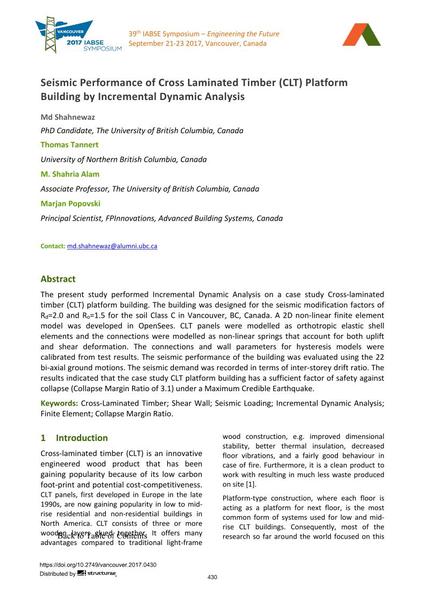Seismic Performance of Cross Laminated Timber (CLT) Platform Building by Incremental Dynamic Analysis

|
|
|||||||||||
Bibliographic Details
| Author(s): |
Md Shahnewaz
(PhD Candidate, The University of British Columbia, Canada)
Thomas Tannert Shahria M. Alam (Associate Professor, The University of British Columbia, Canada) Marjan Popovski (Principal Scientist, FPInnovations, Advanced Building Systems, Canada) |
||||
|---|---|---|---|---|---|
| Medium: | conference paper | ||||
| Language(s): | English | ||||
| Conference: | IABSE Symposium: Engineering the Future, Vancouver, Canada, 21-23 September 2017 | ||||
| Published in: | IABSE Symposium Vancouver 2017 | ||||
|
|||||
| Page(s): | 430-436 | ||||
| Total no. of pages: | 7 | ||||
| Year: | 2017 | ||||
| DOI: | 10.2749/vancouver.2017.0430 | ||||
| Abstract: |
The present study performed Incremental Dynamic Analysis on a case study Cross-laminated timber (CLT) platform building. The building was designed for the seismic modification factors of Rd=2.0 and Ro=1.5 for the soil Class C in Vancouver, BC, Canada. A 2D non-linear finite element model was developed in OpenSees. CLT panels were modelled as orthotropic elastic shell elements and the connections were modelled as non-linear springs that account for both uplift and shear deformation. The connections and wall parameters for hysteresis models were calibrated from test results. The seismic performance of the building was evaluated using the 22 bi-axial ground motions. The seismic demand was recorded in terms of inter-storey drift ratio. The results indicated that the case study CLT platform building has a sufficient factor of safety against collapse (Collapse Margin Ratio of 3.1) under a Maximum Credible Earthquake. |
||||
| Keywords: |
seismic loading cross-laminated timber finite element FE shear wall incremental dynamic analysis Collapse Margin Ratio
|
||||
